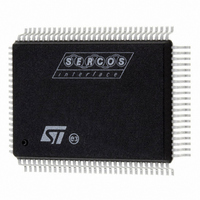ST92F150JDV1QC STMicroelectronics, ST92F150JDV1QC Datasheet - Page 265

ST92F150JDV1QC
Manufacturer Part Number
ST92F150JDV1QC
Description
IC MCU 128K FLASH 100-PQFP
Manufacturer
STMicroelectronics
Series
ST9r
Datasheet
1.ST92F150CV1TB.pdf
(429 pages)
Specifications of ST92F150JDV1QC
Core Processor
ST9
Core Size
8/16-Bit
Speed
24MHz
Connectivity
CAN, I²C, LIN, SCI, SPI
Peripherals
DMA, LVD, POR, PWM, WDT
Number Of I /o
77
Program Memory Size
128KB (128K x 8)
Program Memory Type
FLASH
Eeprom Size
1K x 8
Ram Size
6K x 8
Voltage - Supply (vcc/vdd)
4.5 V ~ 5.5 V
Data Converters
A/D 16x10b
Oscillator Type
Internal
Operating Temperature
-40°C ~ 125°C
Package / Case
100-QFP
Processor Series
ST92F15x
Core
ST9
Data Bus Width
8 bit, 16 bit
Data Ram Size
6 KB
Interface Type
CAN, I2C, SCI, SPI
Maximum Clock Frequency
24 MHz
Number Of Programmable I/os
80
Number Of Timers
5 x 16 bit
Operating Supply Voltage
4.5 V to 5.5 V
Maximum Operating Temperature
+ 105 C
Mounting Style
SMD/SMT
Development Tools By Supplier
ST92F150-EPB
Minimum Operating Temperature
- 40 C
On-chip Adc
16 bit x 10 bit
Case
QFP
Lead Free Status / RoHS Status
Lead free / RoHS Compliant
Other names
497-2137
Available stocks
Company
Part Number
Manufacturer
Quantity
Price
- Current page: 265 of 429
- Download datasheet (8Mb)
I
Figure 127. I
Any transfer can be done using either the I
registers directly or via the DMA.
If the transfer is to be done directly by accessing
the I2CDR, the interface waits (by holding the SCL
line low) for software to write in the Data Register
before transmission of a data byte, or to read the
Data Register after a data byte is received.
If the transfer is to be done via DMA, the interface
sends a request for a DMA transfer. Then it waits
for the DMA to complete. The transfer between the
interface and the I
rising edge of the SCL clock.
The SCL frequency (F
mode is controlled by a programmable clock divid-
er. The speed of the I
between Standard (0-100KHz) and Fast (100-
400KHz) I
10.8.4 I
To enable the interface in I
bit must be set twice as the first write only acti-
vates the interface (only the PE bit is set); and the
bit7 of I2CCR register must be cleared.
The I
(the M/SL bit is cleared) except when it initiates a
transmission or a receipt sequencing (master
mode).
2
C BUS INTERFACE (Cont’d)
2
C interface always operates in slave mode
2
C State Machine
2
C modes.
SCL
SDA
2
C BUS Protocol
CONDITION
START
2
C bus will begin on the next
2
C interface may be selected
scl
) generated in master
2
C mode the I2CCR.PE
MSB
1
2
2
C
The multimaster function is enabled with an auto-
matic switch from master mode to slave mode
when the interface loses the arbitration of the I
bus.
10.8.4.1 I
As soon as a start condition is detected, the
address word is received from the SDA line and
sent to the shift register; then it is compared with
the address of the interface or the General Call
address (if selected by software).
Note: In 10-bit addressing mode, the comparison
includes the header sequence (11110xx0) and the
two most significant bits of the address.
■
■
■
Header (10-bit mode) or Address (both 10-bit
and 7-bit modes) not matched: the state
machine is reset and waits for another Start
condition.
Header matched (10-bit mode only): the
interface generates an acknowledge pulse if the
ACK bit of the control register (I2CCR) is set.
Address matched: the I2CSR1.ADSL bit is set
and an acknowledge bit is sent to the master if
the I2CCR.ACK bit is set. An interrupt request
occurs if the I2CCR.ITE bit is set. Then the SCL
line is held low until the microcontroller reads
the I2CSR1 register (see
sequencing EV1).
8
2
C Slave Mode
ACK
9
CONDITION
I2C BUS INTERFACE
STOP
Figure 128
VR02119B
Transfer
265/429
2
9
C
Related parts for ST92F150JDV1QC
Image
Part Number
Description
Manufacturer
Datasheet
Request
R

Part Number:
Description:
BOARD PROGRAM FOR ST92F150 MCU
Manufacturer:
STMicroelectronics
Datasheet:

Part Number:
Description:
BOARD EVALUATION FOR ST9 SERIES
Manufacturer:
STMicroelectronics
Datasheet:

Part Number:
Description:
BOARD EMULATOR FOR ST9 SERIES
Manufacturer:
STMicroelectronics
Datasheet:

Part Number:
Description:
MCU, MPU & DSP Development Tools ST9 Dedication Board
Manufacturer:
STMicroelectronics
Datasheet:

Part Number:
Description:
STMicroelectronics [RIPPLE-CARRY BINARY COUNTER/DIVIDERS]
Manufacturer:
STMicroelectronics
Datasheet:

Part Number:
Description:
STMicroelectronics [LIQUID-CRYSTAL DISPLAY DRIVERS]
Manufacturer:
STMicroelectronics
Datasheet:

Part Number:
Description:
BOARD EVAL FOR MEMS SENSORS
Manufacturer:
STMicroelectronics
Datasheet:

Part Number:
Description:
NPN TRANSISTOR POWER MODULE
Manufacturer:
STMicroelectronics
Datasheet:

Part Number:
Description:
TURBOSWITCH ULTRA-FAST HIGH VOLTAGE DIODE
Manufacturer:
STMicroelectronics
Datasheet:

Part Number:
Description:
Manufacturer:
STMicroelectronics
Datasheet:

Part Number:
Description:
DIODE / SCR MODULE
Manufacturer:
STMicroelectronics
Datasheet:

Part Number:
Description:
DIODE / SCR MODULE
Manufacturer:
STMicroelectronics
Datasheet:











